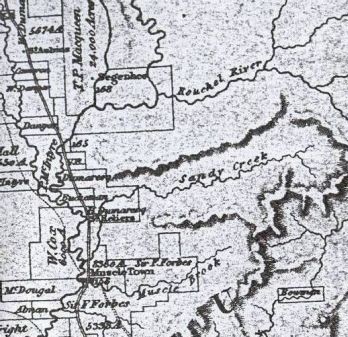Peter McIntyre - Settler
Blairmore - Map 8
Peter McIntyre was born in Perthshire, Scotland in 1783, the son of Donald and Mary McIntyre.

Arrival
In 1824 he was appointed agent for Thomas Potter Macqueen who had received a 10,000 acre grant of land in New South Wales named Segenhoe.Peter McIntyre organised immigrants, livestock and supplies and sailed on the Nimrod and Hugh Crawford arriving in Sydney on 3rd April 1825.
Image: Map showing location of Peter McIntyre's grant. Map is interactive. Click on any names to find nearby settlers
Land Grant
Peter McIntyre also secured a 4000 acre grant from Governor Darling for himself which was called Blairmore and another 4000 acres for his brother John McIntyre which was selected on the Allyn River and named Torryburn.Guided Allan Cunningham
Peter McIntyre guided Allan Cunningham over the Liverpool Ranges in 1827 and the McIntyre River is named in his honour...........Owing to the swollen state of the Hawkesbury, Allan Cunningham did not meet his party at Mr. Glennie's Farm until April 22nd 1827; on leaving there with his men he travelled to Segenhoe, where he arrived on the 26th. He had determined to cross the mountains at the head of Dartbrook Creek where they had already been crossed by Mr. Macintyre, who kindly offered to accompany the explorers to the summit of the Liverpool Range.
On April 30, 1827, Cunningham took his departure from Segenhoe, and, after journeying to Kingdon Ponds, passed over Tullong (or Holdsworthy) Downs. On reaching Dartbrook Creek, he continued his way northwards along its right bank for three and a half miles, halting for the day at a patch of apple-tree flat eighty feet above Segenhoe. Next morning, keeping in the same direction up the right bank of Dartbrook, he descended a grassy valley, and, having accomplished thirteen miles, encamped near its head. This valley was bounded on the north and north-east by a range connected with the Liverpool Range.
Here on May 2nd, Mr. Macintyre and a friend who were to act as guides joined the explorers, and the ascent of the range was begun. Quitting the brook after three miles, Mr. Macintyre led the way in a north-westerly direction to the Range. As they advanced the party rested their horses upon tolerably level spots of grass on the steep hillside. Gradually continuing the ascent they gained a narrow spine of the ridge (bounded on each side by ravines), which became so steep that the loads had to be taken off the pack-horses and carried over on men's shoulders.
On this night (May 2nd) they encamped 2,800 feet above the sea and obtained water in one of the ravines. Next morning Cunningham saw that they had climbed almost to the summit. While he was still engaged in making observations at the camp Mr. Macintyre and his companion directed some of his men with their horses safely over the mountains, leaving them in a valley on the north side of the Liverpool Range, where there were both grass and water, and from which they easily could descend the slopes to the plains. Here the men pitched the tent and awaited the rest of the party.
On returning to the camp, Mr. Macintyre and his friend said good-bye to Cunningham after having rendered him very helpful service. Title: Early Explorers in Australia Author: Ida Lee. Project Gutenberg
Squatter
Peter McIntyre and his brother Donald McIntyre had squatting runs on the Liverpool Plains - Byron Plains, Falconer, Kayuga, Waterloo and Guyra.He was replaced as Macqueen's agent at Segenhoe by Hamilton C. Sempill in 1830.
Death
Peter McIntyre died at Pitnacree near Maitland on 13 January 1842.Notes and Links
1). Select here to find some of the convicts assigned to Peter McIntyre at Segenhoe, Blairmore and Pitnacree.2). Select here to read a description of Peter McIntyre by an old acquaintance in 1839. - Evening News 10 May 1894
3). Location of land Peter McIntyre acquired near Gundy
↑
